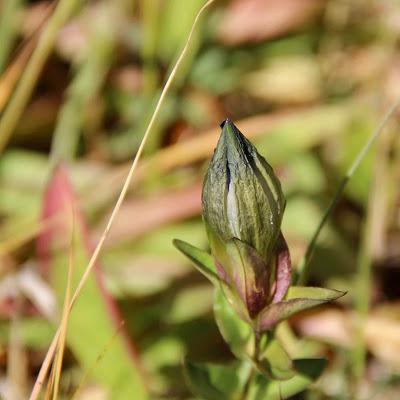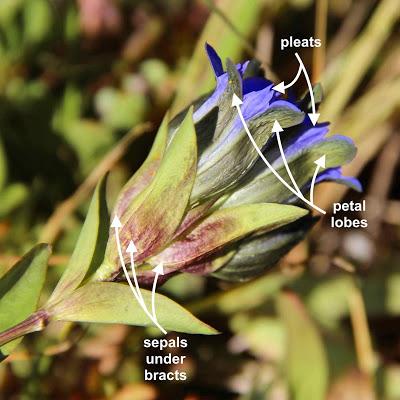
Late summer on upper Deep Creek; Medicine Bow Mountains, Wyoming.
The wet meadow along Deep Creek was mostly dry. I walked through tall grasses and sedges topped with brown seed heads, their leaves turning yellow, and low shrubby willows with lusterless-green upturned leaves. But my feet stayed dry. Tiny ponds and mud holes were the only surface moisture. This is typical for September in the higher mountains.
Short field assistant deals with tall sedges and grasses.
What caught me by surprise were all the rich blue patches of life scattered about—a beautiful contrast! But I shouldn't have been surprised. Pleated Gentians (Gentiana affinis) are always late bloomers. Yet I was caught off guard. It’s not that they were unexpected; they just aren’t part of the seasonal picture until I’m reminded.
But I shouldn't have been surprised. Pleated Gentians (Gentiana affinis) are always late bloomers. Yet I was caught off guard. It’s not that they were unexpected; they just aren’t part of the seasonal picture until I’m reminded.
Pleated Gentian, Gentiana affinis. Both flowers and buds were common.
Gentiana is a large cosmopolitan genus, with on the order of 400 species. Most are native to the Northern Hemisphere. Many grow in montane to alpine habitats, where mountaineers love them for their showy displays on harsh sites, and their proclivity for blooming even as summer winds down.

Arctic or Whitish Gentian, Gentiana algida, “common to alpine settings in the Rocky Mountains.”Matt Lavin photo.
The Pleated Gentian is widespread in western North America, in moist habitats ranging from montane to alpine. Other common names include Trapper’s Gentian and Marsh Gentian (and there are probably more).It’s odd that this gentian is designated "Pleated". True, it does have folds or pleats between the petal lobes. But then so do all true gentians—members of the genus Gentiana (for example the Alpine Gentian above). The botanical term for this flower form is “plicate” meaning folded, like the pleats of a curtain.

Larger blue lobes are petal tips; smaller ones in-between are pleats.

Ragged tips of pleats show nicely in photo of Gentiana affinis by Rolf Englestrand [cropped].
When I first tried to identify this gentian, the flowers led me astray. I assumed that the dull green covering of the buds, which “persists” when the flower opens, was sepals—the outermost whorl of flower parts, usually green. But no … that green tissue is part of the petals. The sepals are indeed green, but they’re tiny and hidden under leaf-like bracts.
Pleated Gentian flower bud; just the green petal tissue is visible (see flower parts below).
 Gentians were a favorite of the great mountaineer, naturalist and conservationist, John Muir. He often mentioned them in descriptions of mountain meadows in the Sierra Nevada of California. Muir especially appreciated their habit of blooming so late in the season, providing much-welcomed color.
Gentians were a favorite of the great mountaineer, naturalist and conservationist, John Muir. He often mentioned them in descriptions of mountain meadows in the Sierra Nevada of California. Muir especially appreciated their habit of blooming so late in the season, providing much-welcomed color.“The gentians don't mind the first frost though their petals seem so delicate; they close every night as if going to sleep, and awake fresh as ever in the morning sun-glory.” from My First Summer in the Sierra (Chapter 10)
